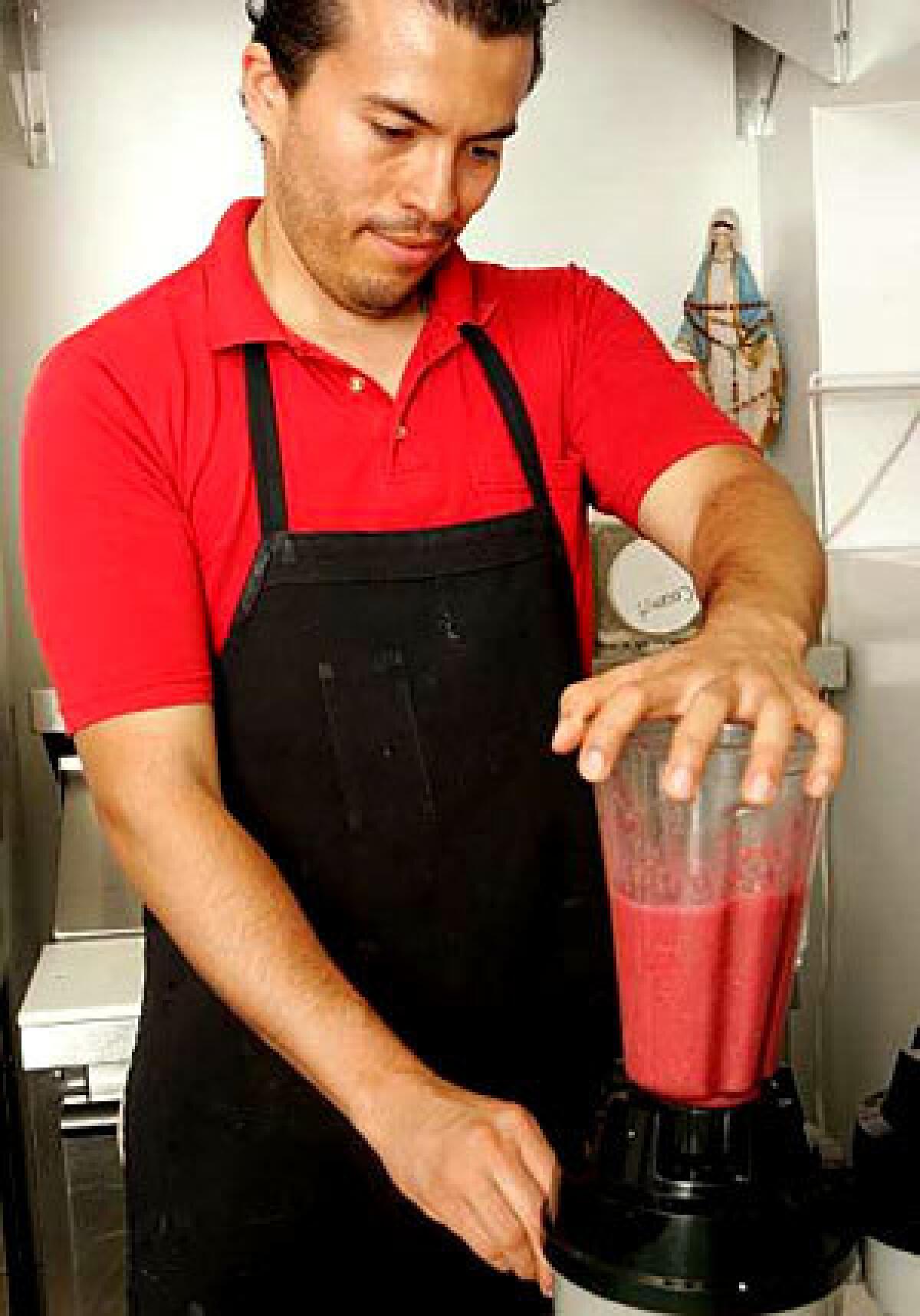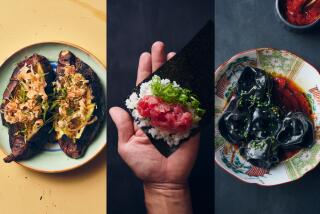L.A. fusion restaurants create easy blends without borders

There are two kinds of fusion cooking. The first kind is self-conscious about its fusion; it exists in order to cross boundaries. It loudly proclaims its own eclecticism with emblematic ingredients -- you know, like tuna sashimi tacos with pomegranate-tahini sauce. It’s theatrical fusion.
But in Southern California, there’s another kind of fusion cooking. It’s happening in homes when someone dips a tortilla chip into some hummus, and it’s happening in small neighborhood restaurants and cafes. It’s bringing us mole made with pistachios, soy milk infused with yerba mate, passion fruit-lavender ice cream and samosas stuffed with mozzarella.
This unselfconscious fusion happens when cooks from one tradition find themselves surrounded by intriguing ingredients from other traditions and start cooking with them, following their own tastes. For these cooks, crossing cultural boundaries isn’t the point; the boundaries are just unimportant. It’s the difference between dating somebody because they’re from an exotic culture, and dating them because you love them and you don’t care where they’re from.
FOR THE RECORD:
Dish’s name: Last week, a list of restaurants offering creative fusion cooking misspelled the name of a dish at the East Los Angeles restaurant Moles la Tia. The dish’s name was misspelled as fianas hierbes mole. The correct name is finas hierbas (fine herbs) mole. —
This natural fusion is, of course, a vital part of food history. It’s what happened when Oaxacan grandmothers started using Dr Pepper in their moles and it worked. It’s what happened when tomatoes came from the New World to Italy and were made into sauce.
Tai Kim is proprietor of Scoops, an ice cream shop on Heliotrope Drive near Melrose Avenue. His shop is a flavor laboratory. In a recent four-week period, his daily-changing flavors included beet-cashew, Korean plum wine and strawberry, bacon-chocolate-peanut butter, salty mascarpone, blackberry-ricotta and Riesling-pineapple.
But Kim, a former instructor at Portland’s Western Culinary Institute, doesn’t think of himself as doing cross-cultural fusion at all. He is, he says, “an educator.” He doesn’t care what cultures the original flavors are from; what matters to him is that there are thousands of flavors out there and millions of untried combinations.
“Sometimes, I’m kind of frustrated,” says Kim. “Some hipster kid comes in because he heard about it and he wants brown bread [Kim’s most widely known unusual flavor], and I mean, come on. There are so many ingredients we haven’t heard of or tried. It’s so hard to convince people [to try something new]. I tell them it’s good, but they don’t want to try. And then they do and they say, ‘Whoa, I’ve never thought about it, that this goes with that.’ ”
Kim chose ice cream as a format for getting people to try new flavors. “After art school, I decided to play with food as a new medium,” he says. “It was such a great medium, instant -- you can see the results right away -- and very approachable for the customers. In a restaurant, people are spending a lot of money, they won’t want to risk it on something new or interesting.”
Soy milk as backdrop
VIET TRAN is another rampant flavor-combiner. His vehicle is soy milk, which he makes every morning by hand, from organic soy beans. “I think there is an art of it,” he explains. “What turned me on to soy milk was the creation of it. It’s more of an art than soup. You cook soy milk for three hours, you feel open, you feel calm. I want to show people how to make soy milk. It’s very meditative, very Zen. Soaking it, blending it, extracting the milk and then cooking it.”
Tran, a former computer programmer, traveled across North Vietnam for five years and studied noodle-making and soy milk-making in little villages. In addition to his tiny Viet Soy Cafe in Silver Lake, he now has Viet Noodle Bar in Atwater Village, perhaps the only place on the planet where you can get a bowl of defiantly traditional Hanoi-style chicken pho in a sharply modern setting. You can also get soy milk in all kinds of configurations -- with black sesame, with yerba mate, with coffee. He’s adding a soy-milk tasting bar, with such flavors as organic garlic (“very sweet,” he says) and turmeric.
“My goal is to pick out what’s good for you -- what’s healthy -- and then to balance it out . . . . make it pleasant, not medicine.”
Health is also the reason behind Olimpus Juices, a smoothie bar run by Jorge and Enrique Mora, brothers from Guadalajara. The Sunset Boulevard bar is tricked out like Mt. Olympus with Grecian columns and busts of Greek gods, and sprinkled with Catholic saint statues and posters for Spanish-language radio stations.
Olimpus serves perfect smoothies -- fresh, frothy and gorgeously fruity. “Our ideas come from necessity,” says Enrique Mora. “We wanted to make something natural, something healthy, with all kinds of vitamins to be strong and whole, without eating something heavy like bread.”
In Guadalajara, he explains, people start the day with juice. The brothers wanted to offer healthful juices here, but they changed the smoothie recipes to make them appealing to Americans. According to Enrique Mora, Guadalajarans are more concerned with the health benefits of juice than with flavor. Fusion recipes in this case mean ones that bring healthfulness and appealing flavors into balance.
Jorge Mora, the resident juice genius at Olimpus, used to be seriously overweight, he says, and turned to smoothie-making on the path to better health. He spent five years perfecting his recipes. His smoothies, he says, are more like home-style Guadalajaran smoothies than those at mainstream smoothie chains.
But in California, he has access to more fruit from around the world -- which is why you can experience his Zeus Thunderbolt, a dense, lush smoothie made of milk, cashews, dates and a varying selection of fresh fruits. He had to add ice -- a highly non-Guadalajaran ingredient, but required for Californians. It was a productive compromise.
“I discovered,” says Jorge Mora, “here in this country, when you add ice to the smoothie, you can taste more of the fruit.”
The art of the mix
KIM, Tran and Jorge Mora say the same thing, that they aim for balance in their foods, not for an explicitly fusioned style. Kim rejects the fusion label. When he’s creating ice cream flavors, he says, he thinks as a painter, using flavors like he used colors. He uses contrasts to create a foreground and a background.
“What’s your intention? What do you really want to bring out?” he asks himself. He tries to create for the customer a narrative over time. “The first flavor comes and you get it, and then the second flavor slowly takes over -- it goes into the first and covers the whole thing. Then it disappears and we come back to the base flavor.”
“It’s like a canvas,” says Tran. “You pick an element you like and you go with it and you balance it out.” Tran isn’t aiming for sharp contrasts in his cooking the way Kim is with his ice creams; Tran tries to meld ingredients into a single integrated flavor.
Contrasting flavors “are like Japanese art, very red and black,” he says. “I like it melded. It’s not traditional; it’s just me. I just don’t like colors. I like black and white and shades of gray -- abstract.”
Tran says he hates the idea of fusion cooking. It’s too intellectual, he says, and cooking should come from the heart.
“I have to list the ingredients, because people have allergies,” he says, “but ideally, I’d only want to list the name. ‘Just taste it,’ I’d say. It doesn’t matter what’s in it.
“When I’m [shopping] at the farmers market, people ask me, ‘What’s that taste like?’ I say ‘Just close your eyes, and taste. Don’t listen to what anybody else says.’
“I started from my experiences, from play,” says Tran, “[My food] isn’t fusion, it’s creation.” He thinks fusion cooking often merely dilutes the traditional dish. What he’s trying to do is “alter the original” to something he loves.
“I’m interested in flavors, not in proclaiming,” says Kim. “You mix together what’s available and sometimes you’re surprised.”
“I’m doing fusion -- and confusion.”
More to Read
Sign up for The Wild
We’ll help you find the best places to hike, bike and run, as well as the perfect silent spots for meditation and yoga.
You may occasionally receive promotional content from the Los Angeles Times.










